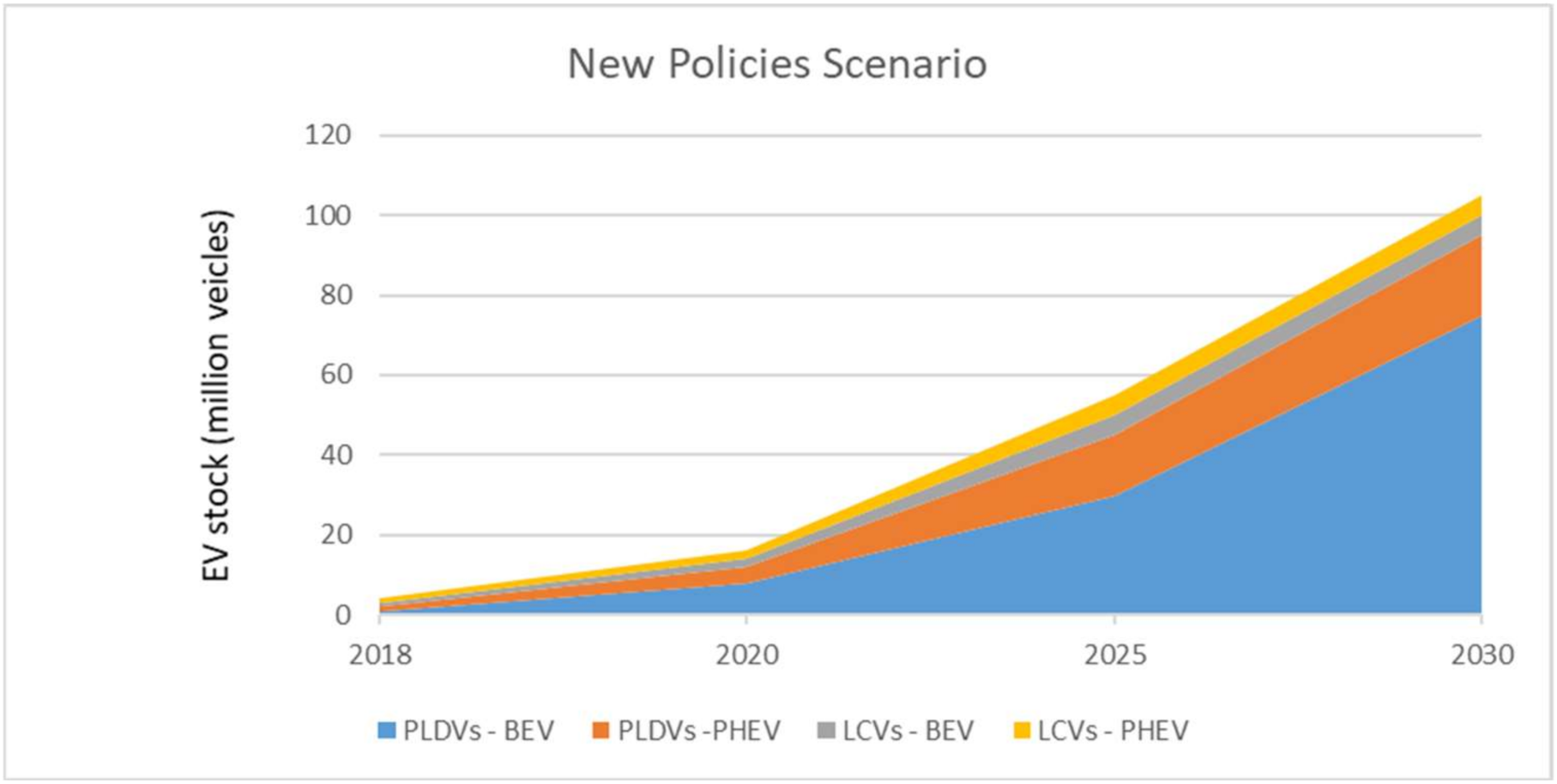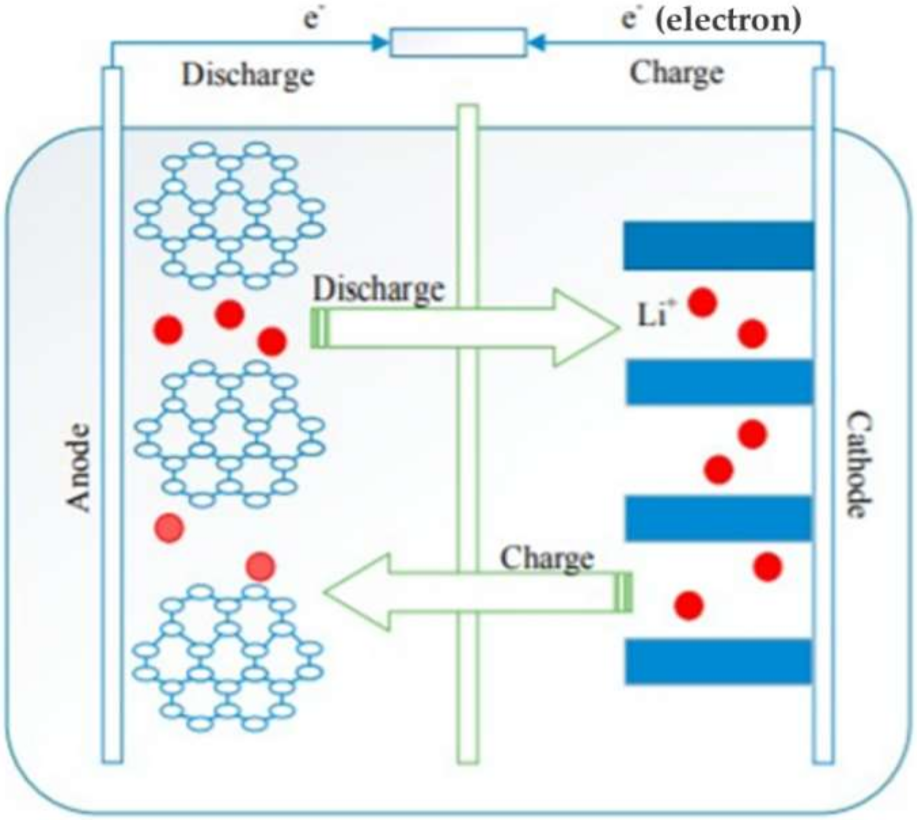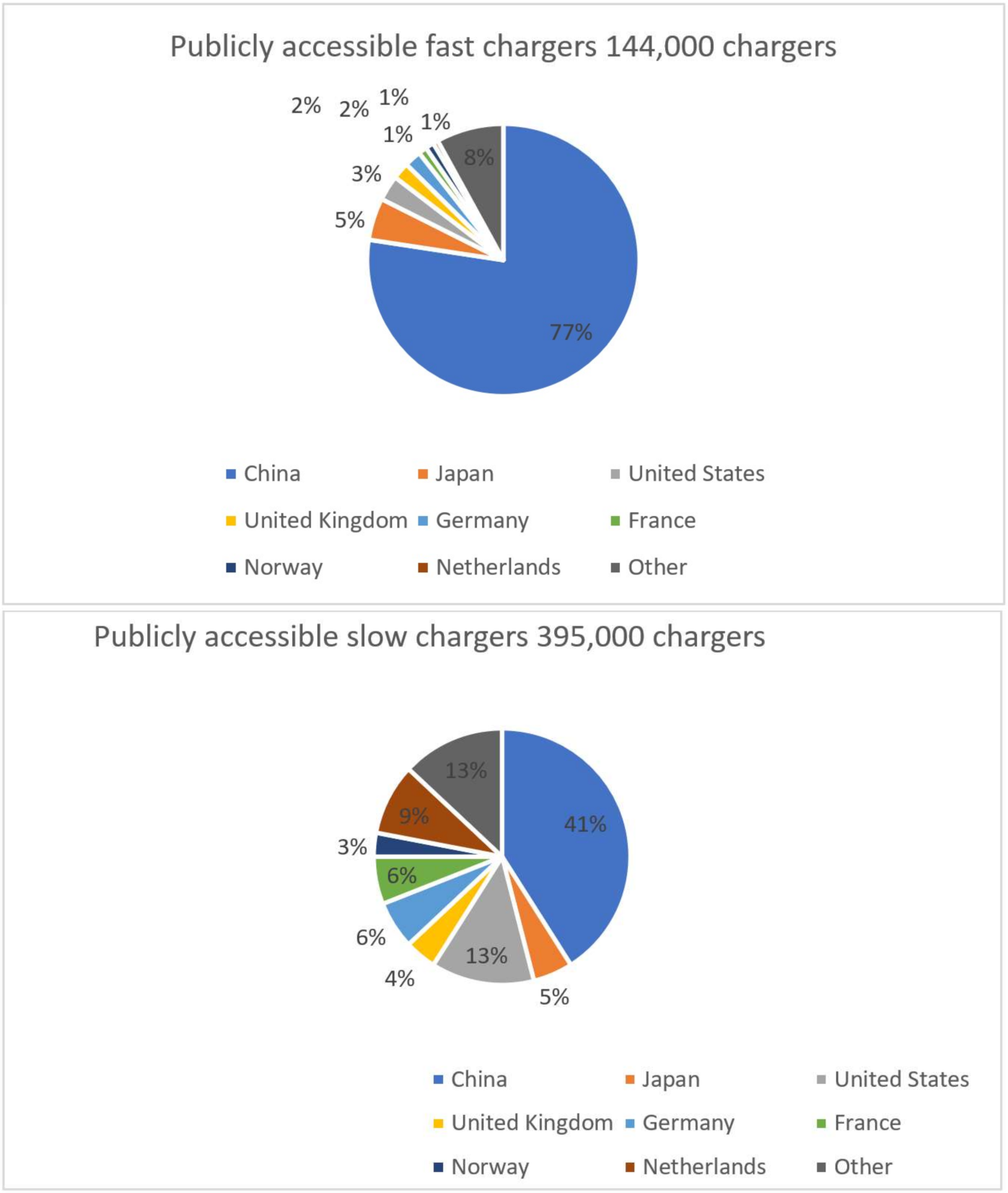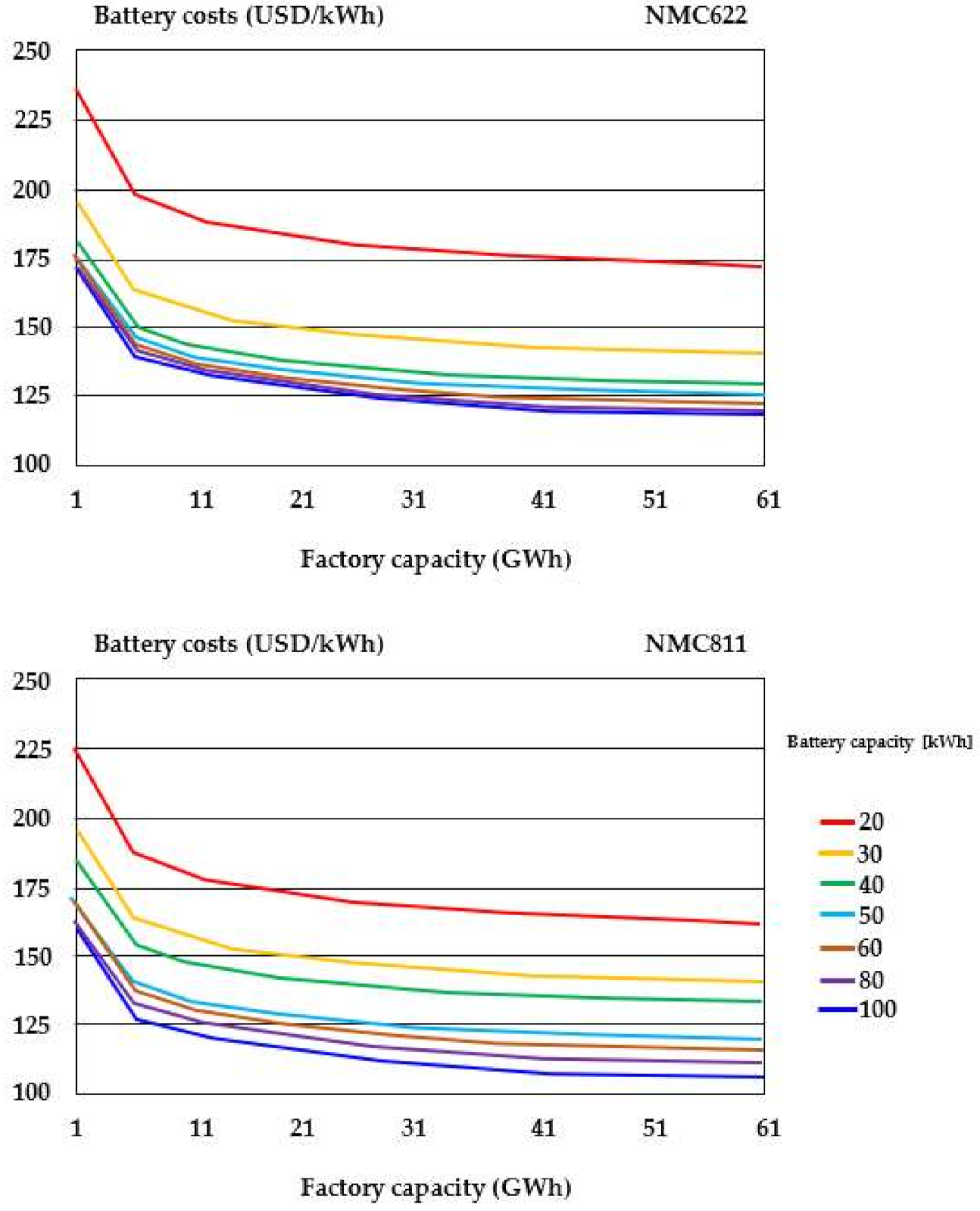High-Performance Electric/Hybrid Vehicle—Environmental, Economic and Technical Assessments of Electrical Accumulators for Sustainable Mobility
Abstract
:1. Introduction
2. Legislative Context
- Improve: incentive policies to improve the performance of current urban mobility systems;
- European Union: use of incentive tools for the use of electric public transport;
- China: policies that may contain investments in the conventional mobility sector and the use of incentives that reward the best performing electric cars;
- Japan: policies to reduce by 80% the greenhouse gas emissions produced by endothermic propulsion vehicles produced in its territory by 2050, using hybrid electric and fuel cell vehicles;
- Canada: British Columbia aims to sell only electric vehicles by 2040;
- India: the “Faster Adoption and Manufacturing of Electric Vehicles in India” program is underway, which consists of encouraging the purchase of both private and public hybrid and electric vehicles;
- Korea: purchase incentives, and reductions in toll and parking costs for low-pollution vehicles.
3. The Technical and Economic Analysis
3.1. Accumulators for Electric Mobility
3.2. Charging Technological Aspects for Electric Vehicles
3.3. Economic Evaluation
- They are able to release current at high intensity;
- High energy density. A lithium battery is capable of accumulating three or four times the energy of a nickel–cadmium (NiCd) battery of the same size;
- Reduced self-discharge. Unlike traditional lead–acid batteries, the self-discharge of lithium-ion batteries is very low and corresponds to only 1–2% per month;
- The memory effect is very small, which is an effect that causes the pre-stations of the old generation batteries to worsen as a result of frequent partial charging. In lithium-ion batteries the capacity remains constant despite sustained use;
- Possibility to perform intermediate recharges of the batteries even if not yet completely discharged. This recharge, total or partial, does not damage the battery;
- A longer service life than batteries that adopt other technologies.
- Susceptible to damage from overload and excessive discharge;
- Due to the very high energy density, great care in handling is required;
- High thermosensitivity of batteries.
4. Environmental Impacts for the Development of Electric Mobility
Decomissioning of Electric Car Batteries
- Decommissioning: the dismantling and removal of the energy storage system.
- Transport of batteries: transportation of old batteries to a refurbishment, recycling or disposal facility.
- Refurbishment and reuse: if feasible, batteries can be reused in “second life” applications, or refurbished—if it is a cost-effective solution.
- Recycling: via pyrometallurgical or hydrometallurgical processes.
5. Engine to Electric Vehicle Retrofitting
5.1. Vehicle Design and Simulation
- The choice of the type of hybridization;
- Vehicle model;
- Endothermic engine model;
- Electric motor model;
- Battery model;
- Generator model;
- Model for transmission;
- Wheel/axle;
- Powertrain control;
- Drive cycle.
5.2. Segment B Vehicle Retrofitting Analysis
5.2.1. Engine Design
- A small hatchback design.
- Length under 4 m.
- A decently sized engine, ranging from a 1.2 L petrol engine upwards.
- Diesel option available, depending on manufacturer.
- Manual or automatic drivetrain.
- Premium car features.
5.2.2. Battery Design
5.2.3. Remarks on Charge Controller Selection
5.2.4. Summary of Technical Specifications
- Electric motor rated power: 100 kW;
- Electric motor type: AC induction;
- Battery capacity: 50 kWh;
- Charge controller: bundled with electric motor.
6. Final Remarks and Conclusions
- o
- Electric mobility has a wide legislative context, based mostly on the country or region and on the current rate of electric mobility implementation;
- o
- The main advantages of Li-ion cells are the higher power, long life cycle and low self-discharge rate. The Li-ion batteries have higher energy density than lead–acid and NiMH, which makes them suitable for a wide range of applications in different industrial sectors;
- o
- Given the assumptions made by lithium-ion battery manufacturers, the cost of these batteries after 2020 should be around 100 EUR/kWh;
- o
- Electric mobility is key for decarbonizing transportation and reducing its environmental impact;
- o
- EV retrofitting can potentially increase the adoption pace of EVs, enhance public acceptance of EVs, lift the resource utilization of ICE vehicles and boost the speed of EV infrastructure development;
- o
- Regarding engine and battery dimensions for a B-Segment vehicle retrofit, an average engine power of 100 kW is recommended. Additionally, a 50 kWh battery is recommended, representing an autonomy of 200 to 230 km. Examples of the selected equipment are shown in the document;
- o
- Retrofitting prices range from about EUR 8000 for smaller cars to about EUR 13,000 to 15,000 for passenger sedans.
Author Contributions
Funding
Institutional Review Board Statement
Informed Consent Statement
Data Availability Statement
Conflicts of Interest
Nomenclature
| ADVISOR | Advanced Vehicle Simulator |
| BEV | Battery Electric Vehicle |
| ECE | Urban Driving Cycle |
| ETC | European Transient Cycle |
| EU | European Union |
| EUDC | Extra Urban Driving Cycle |
| EV | Electric Vehicle |
| HEV | Hybrid Electric Vehicle |
| ICE | Internal Combustion Engine |
| IEA | International Energy Agency |
| IRENA | International Renewable Energy Agency |
| NEDC | New European Driving Cycle |
| SAE | Society of Automobile Engineers |
| STEPS | Stated Policies Scenario |
| SUV | Sport Utility Vehicle |
| WVU | West Virginia Urban Cycle |
References
- JPI Urban Europe Programme. Stimulating a Transition to Sustainable Urban Mobility. Available online: https://jpi-urbaneurope.eu/wp-content/uploads/2018/09/JPI-UE_MaaS_white_paper2018.pdf (accessed on 1 September 2021).
- Husain, I. Electric and Hybrid Vehicles—Design Fundamentals, 3rd ed.; CRC Press: Boca Raton, FL, USA, 2021; ISBN 978-1-138-59058-8. [Google Scholar]
- Turoń, K.; Kubik, A.; Chen, F. Operational Aspects of Electric Vehicles from Car-Sharing Systems. Energies 2019, 12, 4614. [Google Scholar] [CrossRef] [Green Version]
- International Energy Agency. Clean Energy Ministerial. Electric Vehicles Initiative. Global EV Outlook 2019—Scaling up the Transition to Electric Mobility. May 2019. Available online: https://www.iea.org/reports/global-ev-outlook-2019 (accessed on 1 September 2021).
- Barton, B.; Schütte, P. Electric vehicle law and policy: A comparative analysis. J. Energy Nat. Resour. Law 2017, 35, 147–170. [Google Scholar] [CrossRef]
- UN Environment Programme. The Global Electric Vehicle Policy Database. Available online: https://www.unep.org/explore-topics/transport/what-we-do/electric-mobility (accessed on 1 September 2021).
- International Renewable Energy Agency. Renewable Energy Policies for Cities: Transport; International Renewable Energy Agency: Abu Dhabi, United Arab Emirates, 2021; ISBN 978-92-9260-336-6. Available online: https://www.irena.org/publications/2021/May/Policies-for-Cities-Transport (accessed on 2 December 2021).
- Capata, R. Urban and Extra-Urban Hybrid Vehicles: A Technological Review. Energies 2018, 11, 2924. [Google Scholar] [CrossRef] [Green Version]
- Capata, R.; Sciubba, E. Study, Development and Prototyping of a Novel Mild Hybrid Power Train for a City Car: Design of the Turbocharger. Appl. Sci. 2021, 11, 234. [Google Scholar] [CrossRef]
- Reddy, T.B.; Linden, D. Linden’s Handbook of Batterries, 4th ed.; McGraw-Hill Education: New York, NY, USA, 2011; ISBN 13: 978-0071624213. [Google Scholar]
- Tarascon, J.M.; Armand, M. Issues and challenges facing rechargeable lithium batteries. Nature 2001, 414, 359–367. [Google Scholar] [CrossRef]
- Adamec, J.; Danko, M.; Taraba, M.; Drgona, P. Analysis of selected energy storage for electric vehicle on the lithium based. Transp. Res. Procedia 2019, 40, 127–131. [Google Scholar] [CrossRef]
- Beauregard, G.P. Report of Investigation: Hybrids Plus Plug in Hybrid Electric Vehicle. Prepared by ETEC for National Rural Electric Cooperative Association Inc. and U.S. Department of Energy, Idaho National Laboratory, Revision 1. IEEE Transactions on Energy Conversion. 2008, Volume 17, pp. 16–23. Available online: https://prius-touring-club.com/librairie/mediatheque/pdf/toyota-prius-a123-car-fire-investigation-report-2008.pdf (accessed on 2 December 2021).
- Department of Energy, Energy Efficiency & Renewable Energy “Cost and Price Metrics for Automotive Lithiumion Batteries”. Available online: https://www.energy.gov/sites/default/files/2017/02/f34/67089%20EERE%20LIB%20cost%20vs%20price%20metrics%20r9_0.pdf (accessed on 1 September 2021).
- International Energy Agency. Available online: https://www.iea.org/topics/transport (accessed on 2 December 2021).
- U.S. Energy Storage Association. End-of-Life Management of Lithium-Ion Energy Storage Systems. 2020. Available online: https://energystorage.org/wp/wp-content/uploads/2020/04/ESA-End-of-Life-White-Paper-CRI.pdf (accessed on 11 September 2021).
- Hoeft, F. Internal combustion engine to electric vehicle retrofitting: Potential customer’s needs, public perception and business model implications. Transp. Res. Interdiscip. Perspect. 2021, 9, 100330. [Google Scholar] [CrossRef]
- Andrew, B.; Lin, Z. The Economics of the Transition to Fuel Cell Vehicles with Natural Gas, Hybrid-Electric Vehicles as the Bridge. Research in Transportation Economics; Elsevier: Amsterdam, The Netherlands, 2015; Volume 52, pp. 65–71. [Google Scholar]
- Ken Brown Motors. Available online: https://www.kenbrownmotors.co.uk (accessed on 2 December 2021).
- Electric Vehicle Database. Available online: https://ev-database.org (accessed on 2 December 2021).
- Commission of the European Communities. Regulation (EEC) No 4064/89 Merger Procedure. Available online: https://ec.europa.eu/competition/mergers/cases/decisions/m1406_en.pdf (accessed on 2 December 2021).
- EVWest. Curtis 1238e-7621 HPEVS Dual AC-34 Brushless Motor Kit-96 Volt. Available online: https://www.evwest.com/catalog/product_info.php?cPath=8&products_id=170 (accessed on 2 December 2021).
- EVWest. HPEVS Curtis 1238e-7621 96V 650 AMP Controller. Available online: https://www.evwest.com/catalog/product_info.php?cPath=1&products_id=103 (accessed on 2 December 2021).
- EVWest. CALB 180 Ah SE Series Lithium Iron Phosphate Battery. Available online: https://www.evwest.com/catalog/product_info.php?cPath=4&products_id=50 (accessed on 2 December 2021).







| Type of Battery | Cell Voltage (V) | Energy Density (Wh/kg) |
|---|---|---|
| Li-ion (next generation) | 3.8 | 387 |
| Zinc-air | 1.65 | 1086 |
| Li-sulfur | 2.2 | 2567 |
| Li-air | 3 | 3505 |
| Battery Type | Year | Price (USD/kWh) | Number of Lifetime Cycles (n°) |
|---|---|---|---|
| Lead–acid | 100–200 | 500 | |
| Li-ion | 2010 | 700–900 | 1300 |
| Li-ion | 2012 | 350–700 | - |
| Li-ion | 2014 | 280–350 | - |
| Li-ion | 2016 | 175–280 | - |
| Li-ion | 2018 | 125–175 | - |
| Ni-MH | 2004 | 680 | 700 |
| Ni-MH | 2013 | 450–500 | - |
| Ni-MH | 2018 | 265 | - |
| Vehicle Type | Weight (kg) | Electric Motor (kW) |
|---|---|---|
| Compact | 1388 | 95 |
| Mid-size | 1617 | 110 |
| Full-size | 1890 | 140 |
| Small-SUV | 1700 | 120 |
| Mid-size SUV | 2100 | 125 |
| Delivery truck | 7430 | 200 |
| SUV Model | Weight (kg) | Electric Motor (kW) | Battery Type and Capacity (kWh) |
|---|---|---|---|
| Hyundai Kona | 1685 | 150 | Lithium-ion Polymer 64.0 kWh |
| Peugeot 2008 | 1548 | 136 | 50 |
| Opel Mokka | 1550 | 100 | 50 |
| Mazda MX-30 | 1720 | 105 | 35.5 |
| MG ZS | 1620 | 115 | 72.6 |
| DS 3 Crossback | 1598 | 100 | 50 |
| Brand | Model | N° of Vehicles Sold | Power (HP) |
|---|---|---|---|
| Renault | Clio | 248,602 | 65–130 |
| Peugeot | 208 | 199,316 | 74–129 |
| Opel/Vauxhall | Corsa | 198,887 | 69–150 |
| Toyota | Yaris | 179,867 | 69–90 |
| Volkswagen | Polo | 169,467 | 80–207 |
| Electric Motor | Charge Controller |
|---|---|
| Curtis 1238e-7621 HPEVS Dual AC-34 Brushless Motor Kit—96 Volt | HPEVS Curtis 1238e-7621 96 V 650 AMP Controller |
| Motor Face: B-Face | Max Current 650 Amps with Liquid Cooling (2 Min. Max) |
| Motor Diameter: 2260 mm | Rated Power: 50 kW |
| Motor Case Length: 5029 mm | Input Voltage 72–130 Volts |
| Motor Shaft Length End to End: 610 mm | Length: 275 mm |
| Motor Type: AC Induction | Width: 232 mm |
| Brushes: No | Height: 80 mm |
| Interpoles: No | Weight: 5.45 kg |
| Weight: 68 kg | Adjustable Max Output Voltage: 96 |
| Max Voltage Input: 129 V | Switching Frequency: N/A |
| Terminal Stud Size: 9.25 mm | Brake Input Overrides: Yes |
| Integrated Sensors: Encoder Rated Torque: 289 Nm | Error Output Warning Indicator: Yes |
| Rated Power: 95 kW | Precharge Circuit: Built In |
| Continuos RPM: 5000 | Computer Interface: Ethernet Port |
| Max RPM: 10,000 | Data Logging Capabilities: Yes |
| RPM Sensor: No | Tach Output: Yes 1, 2, 4, 6, 8 Pulses |
| Drive End Shaft: 3.175 mm with 6.35 mm Keyway | Limp home Mode: Yes, Controller WillDerate To Keep Pack Above Minimal Battery Voltage |
| Acc/Commutator End Shaft: Optional 22.25 mm with 4.76 Keyway | Firmware Upgradable: Yes |
| Timing: N/A | Internal Contactor: No |
| Max Efficiency: 88% | Thermal Derating: Yes, Derates After Temperature Gets Above 80 °C |
| Thermal Cooling: Internal Fan | Reverse Capability: Yes |
| Max Temperature: 180 °C | Adjustable Acceleration (Slew Rate): Yes |
| Matching Dual Controllers included in Price: Curtis Controller (quantity two) | Idle Function: Yes, 500–1500 RPM (Modern Vehicles Idle from 600–800 RPM) |
| Warranty Period: 1 Year | Programmable Inputs: Yes |
| Programmable Outputs: Yes | |
| Terminal Stud Size: 9.25 mm | |
| RPM Sensor: Internal | |
| Max Efficiency: 88% | |
| Thermal Cooling: Yes, Chill Plate Sold Separately | |
| Warranty Period: 1 Year |
| CALB 180 Ah SE Series Lithium Iron Phosphate Battery |
|---|
| Array: 3 × 30 cell array, total of 90 units, rated power of 51.84 kWh at 96 V |
| Capacity: 180 Ah |
| Height: 275 mm |
| Width: 71 mm |
| Length: 182 mm |
| Weight: 5.6 kg |
| Bolt Size: M8 |
| Voltage nominal: 3.2 V |
| Charge voltage cut-off: 3.6 V |
| Discharging cut-off: 2.5 V |
| Life Cycle (0.3c Charging–Discharging, 80%DOD): 2000 |
| Maximum Discharging Current (10 sec.): 1000 Amps |
| Internal Impedance (1 khz Ac, m-Ω): Less Than 0.8 |
| Chemistry: LiFePO4 |
| Warranty Period: One-year factory warranty on manufacturing defects |
Publisher’s Note: MDPI stays neutral with regard to jurisdictional claims in published maps and institutional affiliations. |
© 2022 by the authors. Licensee MDPI, Basel, Switzerland. This article is an open access article distributed under the terms and conditions of the Creative Commons Attribution (CC BY) license (https://creativecommons.org/licenses/by/4.0/).
Share and Cite
Capata, R.; Calabria, A. High-Performance Electric/Hybrid Vehicle—Environmental, Economic and Technical Assessments of Electrical Accumulators for Sustainable Mobility. Energies 2022, 15, 2134. https://doi.org/10.3390/en15062134
Capata R, Calabria A. High-Performance Electric/Hybrid Vehicle—Environmental, Economic and Technical Assessments of Electrical Accumulators for Sustainable Mobility. Energies. 2022; 15(6):2134. https://doi.org/10.3390/en15062134
Chicago/Turabian StyleCapata, Roberto, and Alfonso Calabria. 2022. "High-Performance Electric/Hybrid Vehicle—Environmental, Economic and Technical Assessments of Electrical Accumulators for Sustainable Mobility" Energies 15, no. 6: 2134. https://doi.org/10.3390/en15062134
APA StyleCapata, R., & Calabria, A. (2022). High-Performance Electric/Hybrid Vehicle—Environmental, Economic and Technical Assessments of Electrical Accumulators for Sustainable Mobility. Energies, 15(6), 2134. https://doi.org/10.3390/en15062134







